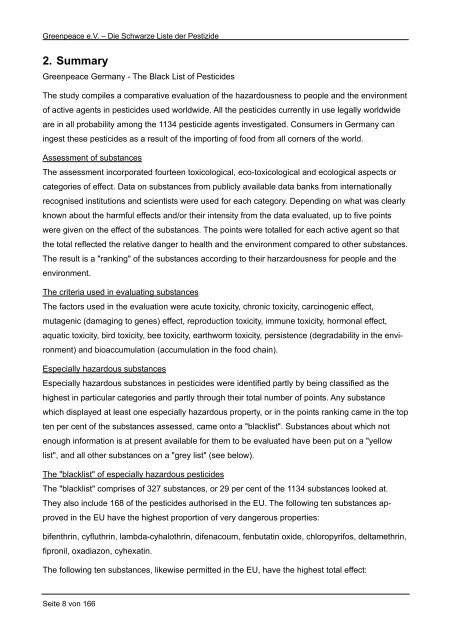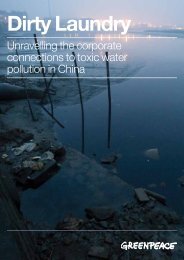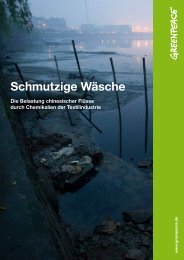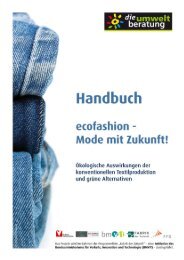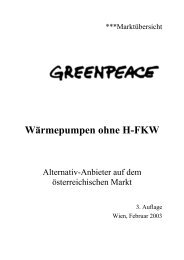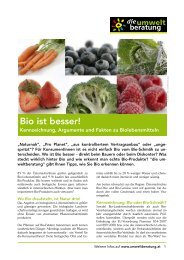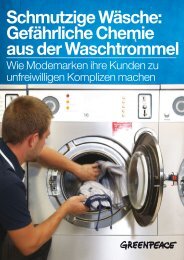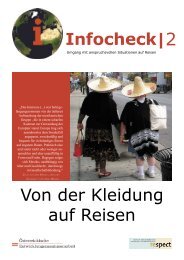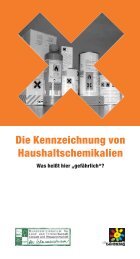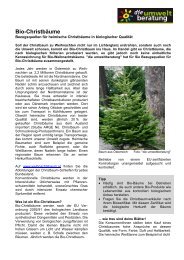Die Schwarze Liste der Pestizide - Greenpeace
Die Schwarze Liste der Pestizide - Greenpeace
Die Schwarze Liste der Pestizide - Greenpeace
Erfolgreiche ePaper selbst erstellen
Machen Sie aus Ihren PDF Publikationen ein blätterbares Flipbook mit unserer einzigartigen Google optimierten e-Paper Software.
<strong>Greenpeace</strong> e.V. – <strong>Die</strong> <strong>Schwarze</strong> <strong>Liste</strong> <strong>der</strong> <strong>Pestizide</strong><br />
2. Summary<br />
<strong>Greenpeace</strong> Germany - The Black List of Pesticides<br />
The study compiles a comparative evaluation of the hazardousness to people and the environment<br />
of active agents in pesticides used worldwide. All the pesticides currently in use legally worldwide<br />
are in all probability among the 1134 pesticide agents investigated. Consumers in Germany can<br />
ingest these pesticides as a result of the importing of food from all corners of the world.<br />
Assessment of substances<br />
The assessment incorporated fourteen toxicological, eco-toxicological and ecological aspects or<br />
categories of effect. Data on substances from publicly available data banks from internationally<br />
recognised institutions and scientists were used for each category. Depending on what was clearly<br />
known about the harmful effects and/or their intensity from the data evaluated, up to five points<br />
were given on the effect of the substances. The points were totalled for each active agent so that<br />
the total reflected the relative danger to health and the environment compared to other substances.<br />
The result is a "ranking" of the substances according to their harzardousness for people and the<br />
environment.<br />
The criteria used in evaluating substances<br />
The factors used in the evaluation were acute toxicity, chronic toxicity, carcinogenic effect,<br />
mutagenic (damaging to genes) effect, reproduction toxicity, immune toxicity, hormonal effect,<br />
aquatic toxicity, bird toxicity, bee toxicity, earthworm toxicity, persistence (degradability in the environment)<br />
and bioaccumulation (accumulation in the food chain).<br />
Especially hazardous substances<br />
Especially hazardous substances in pesticides were identified partly by being classified as the<br />
highest in particular categories and partly through their total number of points. Any substance<br />
which displayed at least one especially hazardous property, or in the points ranking came in the top<br />
ten per cent of the substances assessed, came onto a "blacklist". Substances about which not<br />
enough information is at present available for them to be evaluated have been put on a "yellow<br />
list", and all other substances on a "grey list" (see below).<br />
The "blacklist" of especially hazardous pesticides<br />
The "blacklist" comprises of 327 substances, or 29 per cent of the 1134 substances looked at.<br />
They also include 168 of the pesticides authorised in the EU. The following ten substances approved<br />
in the EU have the highest proportion of very dangerous properties:<br />
bifenthrin, cyfluthrin, lambda-cyhalothrin, difenacoum, fenbutatin oxide, chloropyrifos, deltamethrin,<br />
fipronil, oxadiazon, cyhexatin.<br />
The following ten substances, likewise permitted in the EU, have the highest total effect:<br />
Seite 8 von 166


